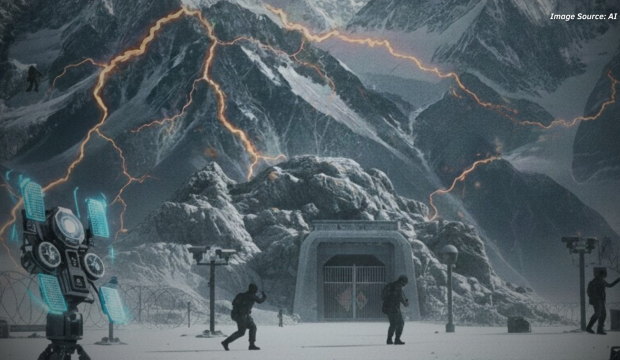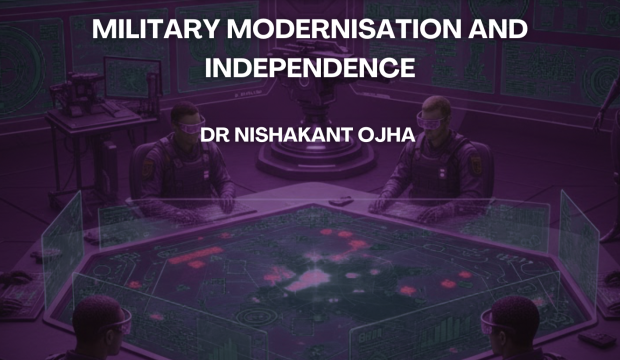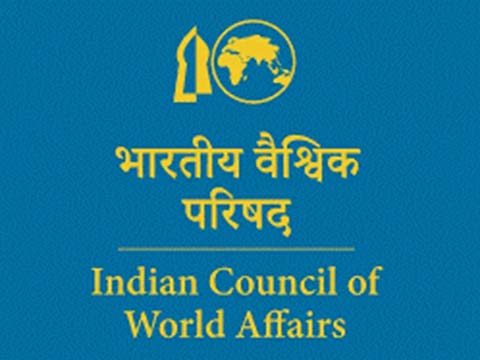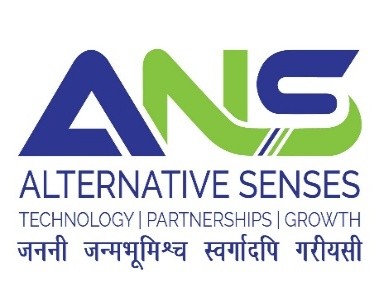Introduction
South Asia is considered to be one of the most volatile nuclear flashpoints in the world. This is due to the presence of the two nuclear-armed neighbours- India and Pakistan, their long-standing rivalry and unresolved territorial disputes. The role played by China in this enduring rivalry further complicates the regional insecurity. Recently, the nuclear dimension of their conflict has become more pronounced, raising concerns. The fact that both India and Pakistan are non-signatories of the Nuclear Non-Proliferation Treaty (NPT) is noteworthy. While global discussions on arms control and disarmament are gaining momentum, nuclear insecurity continues to increase in South Asia, driven by longstanding conflicts and arms control mechanisms.
The acquisition of nuclear weapons by both India and Pakistan is deeply influenced by their history of political and military tension. India tested its first nuclear device in 1974, officially calling it a ‘peaceful nuclear explosion.’ This marked India’s entry
1Abraham, Itty, and M V Ramana. 2024. “India’s 1974 Pokhran Nuclear Test: The Peaceful Explosion That Wasn’t.” Frontline. May 30, 2024.
into the nuclear age clearly stating the strategic intent of sending the message of technological and strategic capability. Pakistan viewed this development as a serious threat, and that resulted in Pakistan accelerating its own nuclear programme. By 1998, both countries had carried out nuclear tests, formally joining the ranks of nuclear-armed states2.
Unlike the five nuclear-weapon states officially recognised under the NPT, the United States, Russia, China, France, and the United Kingdom, India and Pakistan are not signatories to the treaty. India has consistently criticised the NPT for being discriminatory, arguing that it allows a few countries to legally possess nuclear weapons while preventing others from developing them, even for legitimate security reasons. Pakistan has also refused to join the NPT, taking a similar position. This article aims to provide an overview of the nuclear balance between India and Pakistan, highlighting the key challenges that make arms control efforts in South Asia especially difficult.
Current Nuclear Capabilities and Doctrines
Today, both India and Pakistan maintain active nuclear arsenals and have developed delivery systems by land, air, and, in India’s case, at sea. India’s nuclear policy is built around three main principles: credible minimum deterrence, a No First Use
2The Hindu. 2024. “Pakistan PM Sharif Says 1998 Nuclear Tests Ensured ‘Credible Minimum Deterrence.’” The Hindu. May 28, 2024.
3Singh, S. Rajen. “INDIA’S RESPONSE TO NUCLEAR NON-PROLIFERATION MEASURES.” India Quarterly 58, no. 3/4 (2002):
4Press Trust of India. 2015. “Pakistan Says It Will Not Sign Non-Proliferation Treaty.” The Indian Express. June 3, 2015.
(NFU) commitment, and assured second-strike capability. These principles have shaped India’s nuclear stance as cautious and measured, aiming to prevent conflict rather than provoke it. In recent years, some Indian officials have made statements suggesting that the NFU policy could be reconsidered. These remarks have created uncertainty and raised concerns about a possible shift in India’s strategic thinking. For a region as sensitive as South Asia, where historical grievances, political mistrust, and limited communication mechanisms persist, clarity in nuclear policy remains vital for maintaining peace and avoiding dangerous miscalculations.
According to a study on the Status of World Nuclear Forces report by the Federation of American Scientists, India possesses around 180 nuclear warheads while Pakistan has around 170. India has its Agni series of missiles capable of carrying
5Sundaram, Kumar, and M. V. Ramana. 2018. “India and the Policy of No First Use of Nuclear Weapons.” Journal for Peace and Nuclear Disarmament 1 (1): 152–68.
6EurAsian Times Desk. 2019. “Why India Wants to Reverse Its ‘No First Use’ Nuclear Policy? BBC Report.” EURASIAN TIMES. August 24, 2019.
7Kristensen, Hans, Matt Korda, Eliana Johns, and Kate Kohn. 2024. “Status of World Nuclear Forces.” Federation of American Scientists. March 29, 2024.
nuclear warheads8. Pakistan’s missile arsenal includes the Shaheen and Ghauri series, nuclear-capable cruise missiles, to name a few.9
One of the key differences between the two countries lies in their nuclear doctrines. On one hand, India has publicly committed to a No First Use policy, pledging that it would only use nuclear weapons in retaliation for a nuclear attack, on the other, Pakistan, has deliberately avoided adopting NFU and has stated that it reserves the right to use nuclear weapons first if it perceives an imminent threat, particularly from a large-scale conventional attack by India.10 This doctrinal difference introduces a level of unpredictability into South Asia’s strategic environment, increasing the risk of miscalculation during times of heightened tension.
Compounding these concerns is Pakistan’s development of tactical nuclear weapons, smaller, battlefield-ready nuclear arms designed for use against advancing conventional forces rather than strategic targets. These weapons are intended to
8The Economic Times. 2025. “India Maintains Nuclear Edge over Pakistan with More Warheads, Next-Gen ‘Canisterised’ MIRV-Capable Missil.” The Economic Times. Economic Times. June 16, 2025.
9Arms Control Centre. n.d. “Pakistan’s Nuclear Inventory.”
10Tasleem, Sadia. 2016. “Pakistan’s Nuclear Use Doctrine.” Carnegie Endowment for International Peace. 2016.
https://carnegieendowment.org/research/2016/06/pakistans-nuclear-use-doctrine?lang=en.
11Velangi, Amey , and Kartik Bommakanti. 2024. “Pakistan’s Tactical Nuclear Weapons Limit India’s Conventional Military Options.” Orfonline.org. OBSERVER RESEARCH FOUNDATION ( ORF ). June 25, 2024.
deter Indian incursions under doctrines such as “Cold Start,”12 but their deployment raises significant concerns about command and control. Both India and Pakistan are modernising their nuclear forces, adding more advanced technologies and expanding their delivery systems. However, India has already achieved a credible second-strike capability with the deployment of nuclear-powered submarines, which enhances the survivability of its deterrent.13 Pakistan, while working toward similar goals, has yet to develop a fully functional sea-based second-strike platform.14
The China Factor in the India-Pakistan Nuclear Equation
The nuclear relationship between India and Pakistan cannot be fully understood without recognising the central role that China plays in shaping the region’s strategic balance. China’s involvement, both historical and ongoing, acts as a key driver of South Asia’s nuclear dynamics. The support that China extends to Pakistan has added to the already complex security environment and has influenced India’s threat perceptions and nuclear planning.
One of the main reasons for China to maintain close ties with Pakistan is its conflicted relations with India. The China-Pakistan axis has acted as a counterweight to India’s growing power. China provides extensive support to Pakistan’s nuclear development through the transfer of technology and materials. Even after Pakistan became a declared nuclear power in 1998, China has remained a consistent supplier of advanced military technology. This includes dual-use systems, technologies that
12Ibid
13Banerjee, Aritra. 2024. “India’s Nuclear Deterrence at Sea: How the Navy’s Nuclear Subs Will Shape Security in Indo-Pacific – Analysis.” Eurasia Review. November 25, 2024.
14Gady, Franz Stefan. 2015. “Does Pakistan Have a Sea-Based Second-Strike Capability?” Thediplomat.com. The Diplomat. March 13, 2015.
can be used for both civilian and military purposes, as well as conventional weapons that indirectly support Pakistan’s nuclear posture.15 In recent years, more than 81% of Pakistan’s arms imports have come from China.16 Their military cooperation has also expanded to include joint exercises, combat training, and emerging technologies such as artificial intelligence-enabled targeting.17 Indian analysts view this continued support as part of a broader Chinese strategy to keep Pakistan strong enough to challenge India and to ensure that India remains occupied on two fronts.18 While India’s nuclear posture has traditionally focused on Pakistan, the growing Chinese threat has forced India to develop a more flexible deterrence approach that accounts for both adversaries.19
The nuclear situation in South Asia is best described as a “trilemma,” in which India, Pakistan, and China are all part of an interconnected strategic triangle.20 This
15 Peri, Dinakar. 2024. “Chinese Dual-Use Cargo Heading to Pakistan Seized.” The Hindu. March 2, 2024.
16Gera, Ishaan. 2025. “Pakistan’s Reliance on China for Weapons Deepens, While Turkey Climbs to No. 3 Spot.” Moneycontrol. May 8, 2025.
17Pant, Harsh V. 2025. “How China and Pakistan Work against India.” Orfonline.org. OBSERVER RESEARCH FOUNDATION ( ORF ). June 5, 2025.
18Ibid
19Scheers, Alex Alfirraz. 2024. “Understanding India’s Approach to Nuclear Strategy.” Thediplomat.com. The Diplomat. November 6, 2024.
20Thakur, Ramesh, Shatabhisha Shetty, and Waheguru Pal Singh Sidhu. 2022. “China–India-Pakistan Nuclear Trilemma and the Imperative of Risk Reduction
strategic chain links South Asian dynamics to global nuclear trends. As a result, any escalation between India and Pakistan could have broader consequences, potentially drawing in China or complicating efforts at de-escalation. The lack of formal arms control agreements or regional dialogue mechanisms makes this situation even more fragile.
Gaps in Existing Arms Control and Confidence-Building Measures
Even though both nations possess robust arms and delivery systems, formal structures and arrangements to manage nuclear risk, like those prevalent during the Cold War frameworks, are missing.
- Inadequate and Fragile CBMs. India and Pakistan have established some CBMs over the years, such as hotlines, pre-notification of missile tests, and agreements not to attack each other’s nuclear facilities. But these measures are limited in scope, lack robust verification, and are easily reversible. Many existing CBMs are not institutionalised, have no independent monitoring, and are often suspended or ignored during periods of heightened tension.
- Lack of Transparency and Verification. Both countries have not agreed to intrusive verification or monitoring of nuclear-related activities. Compliance is based largely on trust, which is seldom present in their relationship. There is no structured process to review or improve existing CBMs, and no mechanism to address violations or misunderstandings.
- Doctrinal Ambiguity and Asymmetry . India maintains a (softening) No First Use policy, while Pakistan rejects NFU and emphasises the role of tactical nuclear weapons as a counter to India’s conventional superiority. The lack of
Measures.” Journal for Peace and Nuclear Disarmament 5 (2): 215–23.
21Choudhary, Ladhu R, and Haleema Saadia. 2023. “Institutionalizing Nuclear Confidence Building Measures between India and Pakistan – South Asian Voices.” South Asian Voices. November 15, 2023.
clarity in doctrines and red lines increases the risk of misinterpretation and accidental escalation, especially in a crisis.
- Stalled Dialogue and Political Rivalry. Political relations between India and Pakistan are often tense, with dialogue processes frequently breaking down. Without sustained communication, even basic CBMs become difficult to negotiate, implement, or update.
- Emerging Technologies and Arms Control. Today’s strategic environment is not static. Both India and Pakistan are incorporating dual-use and emerging technologies, like artificial intelligence, hypersonic missiles, and cyber warfare, into their nuclear and conventional military planning, which adds new dimensions to existing risks.
Way Forward
- Bilateral Consultative Mechanism. There should be proper verification of the existing CBMs. Annual exchanges of strategic facility lists need follow-up, qualification, and analysis to ensure both sides are acting in good faith. Dialogue exchanges, through official meetings at senior levels, with a supporting secretariat akin to the U.S.-Soviet Joint Institute for Nuclear Research Exchange, would help build trust and resilience.
- Update Existing CBMs. Modernise agreements on pre-notification of missile tests, nuclear facility safety, and hotlines to reflect new technological and doctrinal realities.
- Regional Efforts. Apart from bilateral consultative mechanisms, bringing in China and other multilateral forums can be an option. Even a trilateral dialogue could help manage the dynamics.
CONCLUSION
22PTI. 2024. “India, Pakistan Conduct Annual Exchange of List of Nuclear Installations.” The Hindu. 2024.
South Asia’s nuclear environment continues to be highly unstable. The absence of formal crisis-management structures makes the situation even more dangerous, especially as new military technologies develop at a rapid pace. Without a clear and consistent framework to manage tensions, the chances of an unintended escalation, triggered by misjudgement or miscommunication, remain significant.
One possible way forward could be the establishment of a regional arms control dialogue. Even a modest, well-structured bilateral arrangement between India and Pakistan could serve as a crucial starting point. If both sides commit to regular and transparent communication on nuclear and strategic matters, it would not only lower the risk of sudden military escalations but also contribute to greater confidence and predictability in their relationship. Such steps would strengthen strategic stability in South Asia and support broader international goals of non-proliferation.
In the long term, developing a regional arms control framework is not just a matter of signing agreements; it represents a serious attempt to slow down the arms race and prevent future conflict.
DISCLAIMER
The paper is author’s individual scholastic articulation and does not necessarily reflect the views of CENJOWS. The author certifies that the article is original in content, unpublished and it has not been submitted for publication/ web upload elsewhere and that the facts and figures quoted are duly referenced, as needed and are believed to be correct.
References
- Abraham, Itty, and M V Ramana. 2024. “India’s 1974 Pokhran Nuclear Test: The Peaceful Explosion That Wasn’t.” Frontline. May 30, 2024. https://frontline.thehindu.com/society/india-controversy-1974-pokhran-nuclear-test-atom-bomb-debate/article68230428.ece.
- The Hindu. 2024. “Pakistan PM Sharif Says 1998 Nuclear Tests Ensured ‘Credible Minimum Deterrence.’” The Hindu. May 28, 2024. https://www.thehindu.com/news/international/pakistan-pm-sharif-says-1998-nuclear-tests-ensured-credible-minimum-deterrence/article68224178.ece.
- Singh, S. Rajen. “INDIA’S RESPONSE TO NUCLEAR NON-PROLIFERATION MEASURES.” India Quarterly 58, no. 3/4 (2002): 31–92. http://www.jstor.org/stable/45073412.
- Press Trust of India. 2015. “Pakistan Says It Will Not Sign Non-Proliferation Treaty.” The Indian Express. June 3, 2015. https://indianexpress.com/article/world/pakistan-says-it-will-not-sign-non-proliferation-treaty/.
- Sundaram, Kumar, and M. V. Ramana. 2018. “India and the Policy of No First Use of Nuclear Weapons.” Journal for Peace and Nuclear Disarmament 1 (1): 152–68. https://doi.org/10.1080/25751654.2018.1438737.
- EurAsian Times Desk. 2019. “Why India Wants to Reverse Its ‘No First Use’ Nuclear Policy? BBC Report.” EURASIAN TIMES. August 24, 2019. https://www.eurasiantimes.com/why-india-wants-to-reverse-its-no-first-use-nuclear-policy-bbc-report/.
- Kristensen, Hans, Matt Korda, Eliana Johns, and Kate Kohn. 2024. “Status of World Nuclear Forces.” Federation of American Scientists. March 29, 2024. https://fas.org/initiative/status-world-nuclear-forces/.
- The Economic Times. 2025. “India Maintains Nuclear Edge over Pakistan with More Warheads, Next-Gen ‘Canisterised’ MIRV-Capable Missil.” The Economic Times. Economic Times. June 16, 2025. https://economictimes.indiatimes.com/news/defence/india-maintains-nuclear-edge-over-pakistan-with-more-warheads-next-gen-canisterised-mirv-capable-missiles-sipri/articleshow/121876215.cms?from=mdr.
- Arms Control Centre. n.d. “Pakistan’s Nuclear Inventory.” https://armscontrolcenter.org/wp-content/uploads/2019/08/Pakistan.pdf.
- Tasleem, Sadia. 2016. “Pakistan’s Nuclear Use Doctrine.” Carnegie Endowment for International Peace. 2016. https://carnegieendowment.org/research/2016/06/pakistans-nuclear-use-doctrine?lang=en.
- Velangi, Amey , and Kartik Bommakanti. 2024. “Pakistan’s Tactical Nuclear Weapons Limit India’s Conventional Military Options.” Orfonline.org. OBSERVER RESEARCH FOUNDATION ( ORF ). June 25, 2024. https://www.orfonline.org/expert-speak/pakistan-s-tactical-nuclear-weapons-limit-india-s-conventional-military-options.
- Ibid
- Banerjee, Aritra. 2024. “India’s Nuclear Deterrence at Sea: How the Navy’s Nuclear Subs Will Shape Security in Indo-Pacific – Analysis.” Eurasia Review. November 25, 2024. https://www.eurasiareview.com/25112024-indias-nuclear-deterrence-at-sea-how-the-navys-nuclear-subs-will-shape-security-in-indo-pacific-analysis/.
- Gady, Franz Stefan. 2015. “Does Pakistan Have a Sea-Based Second-Strike Capability?” Thediplomat.com. The Diplomat. March 13, 2015. https://thediplomat.com/2015/03/does-pakistan-have-a-sea-based-second-strike-capability/.
- Peri, Dinakar. 2024. “Chinese Dual-Use Cargo Heading to Pakistan Seized.” The Hindu. March 2, 2024. https://www.thehindu.com/news/national/ship-suspected-to-contain-dual-use-consignment-for-pakistans-nuclear-programme-stopped-at-nhava-sheva-port-in-mumbai/article67906937.ece.
- Gera, Ishaan. 2025. “Pakistan’s Reliance on China for Weapons Deepens, While Turkey Climbs to No. 3 Spot.” Moneycontrol. May 8, 2025. https://www.moneycontrol.com/news/business/china-s-share-of-pakistan-s-arms-imports-has-increased-over-a-decade-13016879.html.
- Pant, Harsh V. 2025. “How China and Pakistan Work against India.” Orfonline.org. OBSERVER RESEARCH FOUNDATION ( ORF ). June 5, 2025. https://www.orfonline.org/research/how-china-and-pakistan-work-against-india.
- Ibid
- Scheers, Alex Alfirraz. 2024. “Understanding India’s Approach to Nuclear Strategy.” Thediplomat.com. The Diplomat. November 6, 2024. https://thediplomat.com/2024/11/understanding-indias-approach-to-nuclear-strategy/.
- Thakur, Ramesh, Shatabhisha Shetty, and Waheguru Pal Singh Sidhu. 2022. “China–India-Pakistan Nuclear Trilemma and the Imperative of Risk Reduction Measures.” Journal for Peace and Nuclear Disarmament 5 (2): 215–23. https://doi.org/10.1080/25751654.2022.2159750.
- Choudhary, Ladhu R, and Haleema Saadia. 2023. “Institutionalizing Nuclear Confidence Building Measures between India and Pakistan – South Asian Voices.” South Asian Voices. November 15, 2023. https://southasianvoices.org/institutionalizing-nuclear-confidence-building-measures-between-india-and-pakistan/.
- PTI. 2024. “India, Pakistan Conduct Annual Exchange of List of Nuclear Installations.” The Hindu. 2024. https://www.thehindu.com/news/national/india-pakistan-conduct-annual-exchange-of-list-of-nuclear-installations/article67695206.ece.

Ms Ashika Prasad
is a Research Assistant at CENJOWS














































